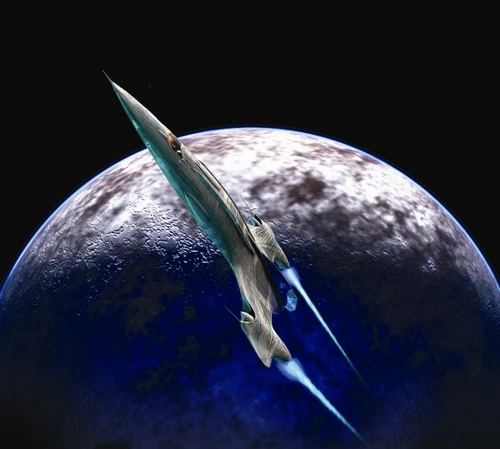No edit summary Tags: Visual edit apiedit |
m (category edit) |
||
| Line 12: | Line 12: | ||
The first scientists to investigate these trees discovered unusual cell differentiation both radially and around the tree's perimeter — animal epithelial cells towards the outside, with soft, lipid membranes, and plant cells further inwards, with cellulose-like cell walls and chloroplasts. |
The first scientists to investigate these trees discovered unusual cell differentiation both radially and around the tree's perimeter — animal epithelial cells towards the outside, with soft, lipid membranes, and plant cells further inwards, with cellulose-like cell walls and chloroplasts. |
||
| − | [[Category: |
+ | [[Category:Species|H]] |
Revision as of 11:45, 29 June 2019
The hamadryad is a large snake-like predator native to the Santiago peninsula on the planet of Sky's Edge. Most information about them is imparted in the novel Chasm City, where much of the action takes place on Sky's Edge. Hamadryads are named for the hamadryads of Greek mythology, for reasons which become obvious with an understanding of the animal's life cycle.
As the climate of Sky's Edge suffers no winter season, there was no ecological niche into which creatures analogous to mammals could evolve. Similarly, the vertebral column never evolved there, so all fauna are invertebrate poikilotherms, with the largest being broadly analogous to reptiles on Earth. Whilst the largest invertebrates on Earth are aquatic, such as squid, large invertebrates on Sky's Edge also populate the land, possibly as the result of a catastrophic event having caused the oceans to shrink. The hamadryad is the largest land-based lifeform native to the planet.
The lack of a spine is handled, by evolution by animals maintaining structural rigidity "through the pressure of circulatory fluids alone, pumped by hundreds of hearts spread throughout the creature's volume".
The life cycle of the hamadryad is rather complex: juvenile and near-adult hamadryads are snake-like limbless creatures, of minimal intelligence, with a very simple central nervous system. The juvenile owned by Cahuella is described as being 12 metres in length and roughly as thick as an adult human's torso for most of that length, weighing more than a tonne. Being limbless, the creatures move like snakes on Earth. Their cold-bloodedness means that they generally move slowly, feeding infrequently, and are remarkably long-lived, with a longevity of hundreds of years. Being the largest native land-based lifeforms, the hamadryad has no real predators.
Juvenile and near-adult hamadryads have no apparent external eyes but, despite this, are capable of camouflaging themselves to match their surroundings. Contrary to this belief these pre-adult hamadryads do in fact have eyes. Eyes with remarkable visual acuity, set inside the upper roof of the jaw and spaced apart for binocular vision. Whilst hunting and preparing to ambush, prey are additionally triangulated with a host of other senses, such as infrared vision and smell.
At the end of the near-adult phase, adult hamadryads bond with a hamadryad tree, their bodies becoming part of the bark. The first explorers on Sky's Edge didn't investigate the hamadryad trees very well before the planetary war began, so the nature of the creatures' life cycle was not immediately apparent. The trees are relatively rare, but distributed across a large part of the Santiago peninsula, rising to a height of 40–50 metres above the forest floor. They are broadly cylindrical in shape, thickening towards the base, with an almost metallic-looking helical structure wrapped around the length of the trunk and a wide canopy at the top, tens of metres in diameter.
The first scientists to investigate these trees discovered unusual cell differentiation both radially and around the tree's perimeter — animal epithelial cells towards the outside, with soft, lipid membranes, and plant cells further inwards, with cellulose-like cell walls and chloroplasts.
